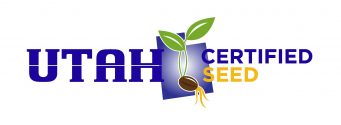Superior crop varieties (and pre-variety native plant germplasm selections) are essential to the maintenance of the world food supply and reclamation efforts on range and wildlands disturbed by natural and human caused events. Much effort, time and money are spent by public and private plant breeding groups in variety development and germplasm selection to meet this need.
In order for agriculture and reclamation efforts to benefit from these released varieties and germplasms, it is vital that every means be taken to preserve and maintain them. The identity and purity of new varieties can be easily lost through out-crossing, contamination or errors in the seed field, cleaning facility, or labeling. Seed certification and Foundation stock seed programs successfully avoid these pitfalls and maintain and distribute new varieties and germplasm selections of known identity and purity through commercial channels to the consuming public.
UCIA History
Seed certification has been a viable program in Utah since 1926, when Utah became a member of the International Crop Improvement Association (since 1966 called the Association of Official Seed Certifying Agencies). The Utah State Department of Agriculture and Food (UDAF) have basic responsibility for seed certification in Utah, as authorized by the Federal Seed Act, and administered it directly until 1937. In that year the Utah Crop Improvement Association (UCIA), a non-profit corporation of seed growers and conditioners, was organized and designated as the official state certification agency.
The UDAF provided oversight for the UCIA until 1947, when the Utah Agricultural Experiment Station (UAES) at Utah State University was given that responsibility. The Experiment Station retained the UCIA as the official certifying agency for Utah, and by memorandum of understanding the UAES Seed Certification Specialist acts as Secretary-Manager of the Association.
Seed certification in Utah is conducted according to the Seed Certification Requirements and Standards of the Utah Crop Improvement Association, revised in 1985 and 1991 and updated as necessary. These standards meet or exceed the minimum genetic standards of the Association of Official Seed Certifying Agencies (AOSCA), which are part of the U.S. Federal Seed Act.
Certified Crops
Over the years, alfalfa can be considered the major seed crop in Utah, with over 16,000 acres in 1955 applied for certification. Since that time, the total certified acreage for all crops has decreased to around 5,000 acres annually, and the balance has shifted to small grains. Most recently, grass seed (primarily native and introduced wheatgrasses and other drought tolerant species developed by the USDA/ARS and other federal and state agencies in Utah) has become a significant portion of certified acreage. Other crops the UCIA has certified over the years include asparagus, beans, peas, clover, corn, mint, onions, potatoes, safflower, and various native shrubs and forbs.
Source Identified Seed
Source Identified program to verify the harvest site and species of wild collected native (or naturalized) plant seed has been functional since 1998. This program has had a significant impact on the reclamation seed industry as major seed consumers (BLM, Forest Service, etc.) are preferentially specifying official source identified seed. By planting source identified seed the seed origin and the reclamation site ecology and environment can be more closely matched. Over the last few years source identified seed volume has ranged from update numbers 250,000 lbs. annually to over 750,000 lbs. annually representing over 40 species and 25 to 40 collector groups / seed brokers.

